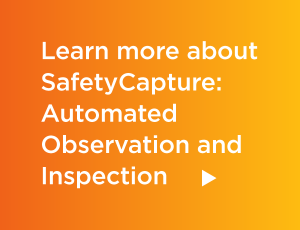 In the domain of Behavior-Based Safety (BBS), practitioners have traditionally relied on paper forms that make it easy for workers to record their safety observations in the field. But as mobile and handheld computing innovations—including smart phones and tablets—continue to play an increasingly important role in many businesses’ IT strategy, will they revolutionize the data collection process in BBS?
In the domain of Behavior-Based Safety (BBS), practitioners have traditionally relied on paper forms that make it easy for workers to record their safety observations in the field. But as mobile and handheld computing innovations—including smart phones and tablets—continue to play an increasingly important role in many businesses’ IT strategy, will they revolutionize the data collection process in BBS?
That’s a strategic question that many safety program managers, participants and executives are currently evaluating. Paper might be considered low-tech, but it’s also practical, inexpensive and familiar: workers can incorporate it easily into their work environments and job processes, without significant disruption or loss in productivity. The challenge becomes how to get the safety data captured in those paper forms into spreadsheets, databases or online systems for processing and distributing key safety insights to decision-makers across the enterprise.
Wrestling with the Data Dilemma: Can Mobile Help?
Most large plants and production facilities have wrestled with this data dilemma, and many are in the middle of evaluating their technology strategy when it comes to safety observation data management. Mobile applications and devices are increasingly at the forefront of new technology business cases. That means getting the right mobile technology (including smart phones or tablets) into the hands of front line workers who are critical for capturing at-risk and near-miss behaviors, and using real-time, online connectivity to transmit behavioral data to collection systems, databases and reporting systems.
In theory, moving safety observation data gathering into a mobile environment might sound like an attractive proposition. However, for organizations focused on safety measurements as a key indicator of corporate performance, the decision is complicated by many other factors.
“Large industrial environments can vary a great deal from sector to sector, and many workplaces are dangerous places with multiple hazards,” said Rick Wynne, product manager at Scantron. “In these challenging operating environments, putting more technology in workers’ hands is not always the right solution to facilitate the safety observation process. It’s imperative that organizations understand the full scope of the mobile investment and what that means for their safety program budgets. Since safety programs often face budgetary and IT restrictions, technology changes typically happen at an evolutionary – not revolutionary – pace. What’s important is finding the right balance of tried and tested methods, and incorporating creative ways to use affordable technology to solve the biggest problems.”

Understanding the Mobile Investment
As organizations come to grips with what a mobile-enabled data collection strategy entails, the technology investment picture expands. While smart mobile devices like tablets and smart phones are becoming more affordable, hazardous work environments – think industries like Mining, Oil & Gas, and Manufacturing – often lead to device damage and higher hardware replacement costs. Lost or damaged devices not only add replacement costs to already tight budgets, they also create disruptions that prevent the recording of time-sensitive safety observations. This delay can increase the potential for workplace injury, while slowing the identification of at-risk and near-miss behaviors.
In addition, often organizations can place too much emphasis on the cost of mobile hardware devices, without doing enough due diligence on the application side. While converting a paper observation form for use on a web-enabled mobile device might seem like a fairly simple exercise, the cost of developing mobile applications can be daunting.
“It’s estimated that mobile applications can cost anywhere from $20,000 for fairly simple applications to upwards of $150,000 for more complex applications with multiple functions,” adds Wynne. “It’s also critical to factor in the cost of maintaining and extending mobile applications as data gathering objectives change over time. It’s common for organizations to modify their approach to safety and track different indicators as their programs evolve, all of which have an impact on the design and coding of the forms that workers complete. If organizations don’t have sufficient IT and executive support behind their mobile data strategy, these initiatives can put even more pressure on the viability of behavior-based safety programs.”
Finding the Right Balance
No one is suggesting that behavior-based safety programs should ignore the efficiency and productivity benefits that mobile technology can deliver. Instead, many safety industry experts are recommending that the pace of technology change should be balanced against the practical realities of data collection and organizational support.
The most effective technology strategy isn’t always about leap-frogging current investments in favor of the latest innovations. Most organizations simply can’t afford to do that in the current economic climate. Many proponents of BBS agree that technology evolution must be a managed migration over time. It must also focus on addressing the data problem and enabling the feedback loop – two safety program priorities that help to decrease workplace injuries, increase program engagement and drive greater production efficiency. The use of paper forms within the data collection process remains a cost-effective, flexible approach with few organizational barriers.
 “Sometimes safety program managers conclude that a paper-based system must be a key part of the data collection problem,” said Wynne. “When deployed in tandem with the right data automation support, paper forms can be an efficient mechanism for capturing and processing safety observations. Instead of replacing paper forms with a suite of costly mobile devices and applications, organizations can turn to data automation solutions that allow them to get the best of both worlds. They can continue to leverage all of the cost and simplicity advantages of paper observation forms, but also enjoy same-day access to digital data that can be seamlessly passed along to their reporting systems for consumption. This process can be further accelerated with on-demand data automation solutions that include integrated reporting capabilities, helping organizations avoid additional steps like translating and merging data.”
“Sometimes safety program managers conclude that a paper-based system must be a key part of the data collection problem,” said Wynne. “When deployed in tandem with the right data automation support, paper forms can be an efficient mechanism for capturing and processing safety observations. Instead of replacing paper forms with a suite of costly mobile devices and applications, organizations can turn to data automation solutions that allow them to get the best of both worlds. They can continue to leverage all of the cost and simplicity advantages of paper observation forms, but also enjoy same-day access to digital data that can be seamlessly passed along to their reporting systems for consumption. This process can be further accelerated with on-demand data automation solutions that include integrated reporting capabilities, helping organizations avoid additional steps like translating and merging data.”
Looking Ahead
While there’s little doubt that mobile technology will continue to support BBS in the future, the economic reality of current safety programs dictates a conservative, cost-sensitive and selective approach to technology innovation. Organizations should pay close attention to both the potential risks and rewards, while making strategic decisions that preserve the long-term goals of the safety group.
Mobile technology provides a tantalizing glimpse of what is possible, and is already being used by some organizations to automate checklists, observations and reporting processes. However, as organizations look to enhance the technology infrastructure that supports their BBS programs, they will almost invariably be focusing on incremental upgrades with proven return on investment – not wholesale replacement of their data collection systems. With the addition of cost justified IT investments like on-demand solutions for data automation, organizations can implement affordable solutions to prevent manual data entry from becoming a bottleneck.
“The practical limitations of in-the-field behavior observations point to a future that includes, but is not constrained by, paper forms,” Wynne adds. “Enabling data automation solutions provide many of the perceived advantages of end-to-end mobile systems – near real-time data collection and reporting capabilities chief among them — yet insulate organizations from the financial risks that come with emerging technology.”


Social
View our latest posts or connect with us below on Social Media.